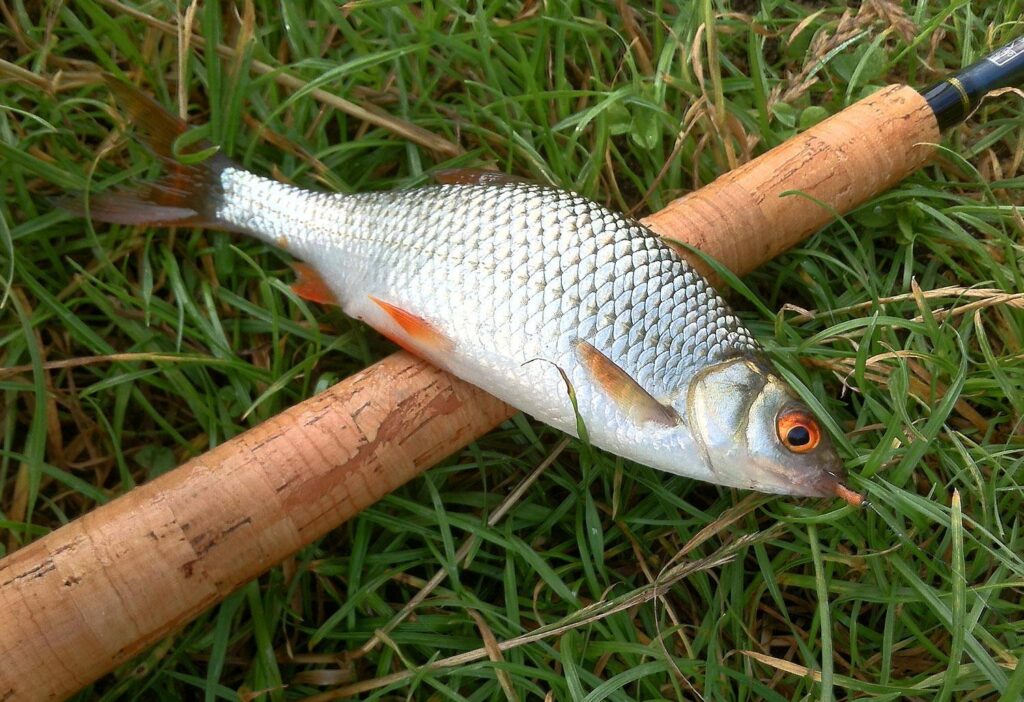Karšis, kaip ir kai kurie kiti karpinių žuvų atstovai, turi pastebimai suspaustą kūną. Vizualiai šios žuvys lengvai atpažįstamos pagal kūno išvaizdą. Jis lygus 1/3 viso ilgio. Dėl aukšto ir susiaurėjusio nugaros peleko žuvis atrodo dar didesnė, nei yra iš tikrųjų. Karšiai turi asimetrinį peleką uodegos srityje.
Analinis pelekas turi 30 spindulių. Karšis jį naudoja kaip kilį, suteikiantį stabilumo. Žuvies galva nėra labai didelė, akys mažos. Burna taip pat yra maža. Žuvies kūno paviršiuje yra nedidelių žvynelių, bet nugaros srityje jų nėra.
Su amžiumi karšių spalva keičiasi. Jauni karšiai turi pilkšvą arba sidabrinį atspalvį. Bėgant laikui, žuvies spalva tamsėja. Dėl to karšiai tampa rudesni arba juodesni. Yra būdingas gelsvai auksinis atspalvis. Skiriasi ir žuvų pelekai. Juos galima pamatyti nuo šviesiai pilkos iki kraujo raudonumo.
Karšis užauga iki 40-75 cm ilgio ir 5-7 kg svorio.
Kur gyvena karšis
Karšis – būrinė žuvis. Karšiai grupėje mieliau laikosi gilesnėse vietose, kur daug augmenijos. Karšiai minta augalinės ir gyvulinės kilmės masalais.
Karšiai yra sėslios žuvys. Net upėse jie laikosi konkrečios teritorijos. Tačiau pusiau anadrominiai karšiai gali gyventi ir atskiruose rezervuaruose. Tokios neršti skirtos žuvys juda gana toli prieš srovę. Žiemai dauguma individų vis dar lieka tomis pačiomis sąlygomis, pasirenkant paprastas povandenines duobes.
Karšiai pasižymi vienu įdomiu elgesio bruožu. Kartais jie susirenka į labai didelius pulkus, o tada juda dugnu, pasirinkdami iš jo viską, ką galima valgyti. Karšiai primena tikrus kombainus, nuimančius kviečių lauką. Kartais tokio pulko praėjimą galima stebėti nuo kranto. Žuvies judėjimo maršrutą galima labai lengvai sekti oro burbuliukais kylančiais į paviršių kurie išsiskirią iš dugno dumblo.
Kuo minta karšis
Svarbiausias karšių raciono komponentas, be įvairių smulkių vėžiagyvių, yra dugno dumble gyvenanti uodo trūklio lerva (Liaudiškai – matylius).
Be to, karšiai aktyviai minta ir vandens augmenija. Maitindamasis karšis su vandeniu pasisavina visus reikalingus maisto komponentus, kurie vėliau sulaikomi specialių ataugų pagalba. Žiaunų grėbliai yra išdėstyti dviem eilėmis išilgai kiekvienos žiaunos. Tuo pačiu metu žiauniniai grėbliai, nors ir trumpi, yra gana stori, su skersiniais kanalais. Būtent skersiniuose kanaluose nusėda reikalingas maistas. Vėliau vanduo išstumiamas pro žiaunų gaubtus.
Todėl galime drąsiai teigti, kad karšiai daugiausia minta mažais maisto objektais, tokiais kaip uodo trūklio lervos ir maži vėžiagyviai, zoo planktonu. Tokia žuvų dieta siejama su jos anatomine struktūra, tiksliau, išvystytais žiauniniais grėbliais su specialiu raumeniu. Šis raumuo kontroliuoja žiaunų grėblių darbą. Toks unikalus mechanizmas leidžia karšiams greitai tapti dominuojančia rūšimi savo natūralioje aplinkoje, išstumiant iš savo buveinės tokias žuvis kaip kuojos ar plakiai.
Kada neršia karšiai
Mūsų šalies teritorijos daliai būdinga, kad karšiai pradeda neršti gegužės-birželio mėnesiais. Iki neršto pradžios karšių pulkai susiskirsto į grupes pagal amžių. Patinų galvos srityje atsiranda maži spuogeliai, labiau panašus į bėrimą.
Žuvys neršti iškeliauja grupėmis, o kiekviena grupė išeina neršti vėliau nei kiekviena ankstesnė. Karšių nerštavietės yra arti įprastų gyvenimo buveinių ir aptinkamos sekliose vietose su žolėtu dugnu. Į nerštavietes pirmiausia patenka patinai, po to patelės.
Kiekviena grupė neršia keletą dienų, nors daug kas priklauso nuo buveinių pobūdžio ir oro sąlygų. Karšių ikrai turi šiek tiek gelsvą atspalvį. Patelė padeda iki 150 tūkstančių ikrų.
Kiaušiniai tvirtai pritvirtina prie vandens augalijos. Ikrai, kurie negalėjo prisitvirtinti, plūduriuoja vandens paviršiuje kur juos suvalgo paukščiai. Normaliam kiaušinėlių vystymuisi vandens temperatūra neturi nukristi žemiau +10 laipsnių. Esant pastebimam vandens atšalimui, galima masinė ikrų mirtis.
Svarbu žinoti!
Priklausomai nuo klimato sąlygų, karšiai subręsta skirtingu laiku. Šiltesniuose kraštuose jie pasiruošę neršti sulaukę 3–5 metų, o šaltesniuose – karšiai gali subręsti tik 5–9 metų amžiaus.
Po neršto karšiai sudaro daugybę pulkų ir palieka savo tradicines nerštavietes. Po neršto karšiai pradeda aktyviai maitintis.
Naudingos žuvies savybės
Tarp žvejų priimtiniausiu laimikiu laikomi stambūs karšiai. Kai kurių ekspertų teigimu, karšis yra plona ir kaulėta žuvis, tačiau iš tikrųjų jo mėsoje yra iki 9 procentų sveikųjų riebalų. Todėl karšio mėsa yra švelni ir minkšta. Mažesnių individų mėsa yra tikrai liesa ir sausa, o dėl daugybės kaulų ji prastesnės kokybės.
Įdomiausia, kad karšis laikomas riebiausia žuvimi. Taip pat manoma, kad karšio riebalai yra naudingiausi, nes jie nėra apdorojami, dalyvauja kraujagyslių valymo procese, o vitaminas D padeda stiprinti kaulus.
Tai unikalus produktas, nes jame yra Omega-3 riebalų rūgščių. Būtent šios rūgštys mažina cholesterolio kiekį kraujyje ir tirpdo cholesterolio plokšteles, valo kraujagysles, o tai savo ruožtu mažina širdies ir kraujagyslių ligų riziką.
Be naudingų žuvų taukų, karšiai gali tapti vitaminų ir mikroelementų, taip reikalingų žmogaus organizmo gyvybei, šaltiniu.
Kalbant apie karšių kepimą, reikia atminti, kad keptas karšis laikomas skaniausiu ir sveikiausiu, tačiau tai visiškai nereiškia, kad jo negalima gaminti pagal kitus receptus. Daugelis žino, kas yra – skanus rūkytas karšis. O mano vienas iš mėgstamiausių ir paprasčiausių receptų – karšis orkaitėje. Kaip jį pagaminti galite paskaityti šiame mano straipsnyje.
Pabagai
Yra daug įdomių faktų apie šios žuvies gyvenimą. XX amžiaus pradžioje Kaspijos jūros baseine kasmet buvo sugaunama iki 20 mln. tonų karšių. Ko negalima pasakyti apie mūsų laiką, kai įvairių žuvų rūšių populiacijos nuolat mažėja. Pagauti didelį karšį – didžiausia bet kurio žvejo mėgėjo svajonė. Deja, šiais laikais trofėjų egzemplioriai yra gana reti. O dėl visko kaltas žmogus, kuris sparčiais tempais teršia telkinių vandenis. Be to, upėse statant įvairius hidrotechnikos statinius, žuvys negali patekti į natūralias nerštavietes. Taip pat didelį indelį į karšių populiacijos nykimą deda verslinė žvejyba, jie padaro didelę žalą karšių skaičiui, gaudydami didžiausius ir produktyviausius individus.
Laimei, planetoje vis dar yra sunkiai pasiekiamų vietų, kur žuvys nejaučia jokio pastebimo žvejybos entuziastų „spaudimo“. Deja, kai kurie šiuolaikinės civilizacijos elementai žmogui tampa vis labiau prieinami, ir jis vis dažniau bando patekti į šias vietas, kur žuvys vis dar jaučiasi saugiai.
Žvejyba – tai visų pirma poilsis ir kiekvienas siekia prisiliesti prie gamtos, kad pasipildytų jėgomis ir energija. Todėl nenuostabu, kad savaitgaliais ežerų pakrantės tiesiog nusėtos žvejybos mėgėjais. Ar galima uždrausti? Vargu!! Būkime atsakingi ir saugokime žuvų išteklius ir laikykimės žvejybos taisyklių!












